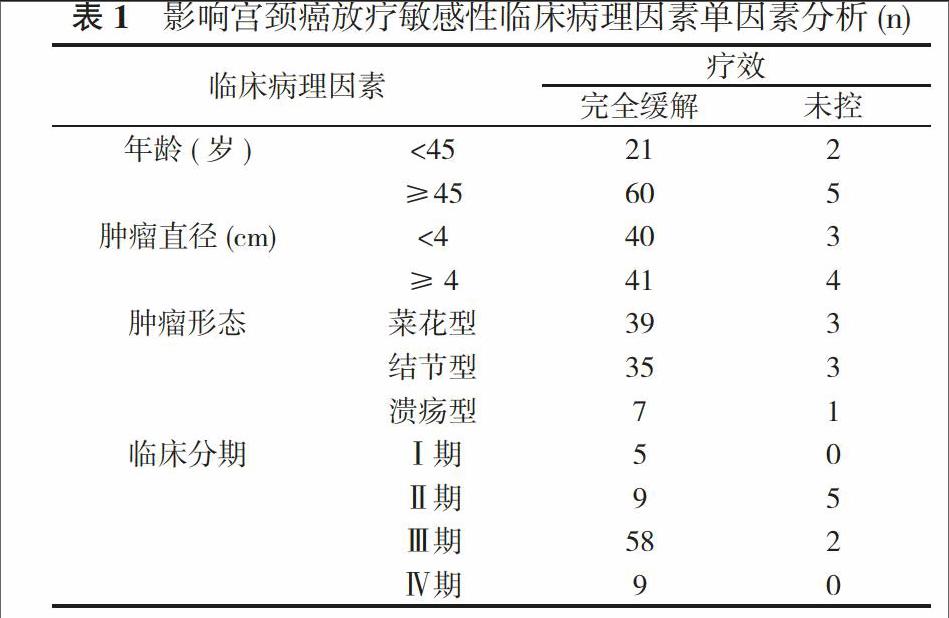影响宫颈癌放疗敏感性的临床病理因素分析
2016-07-26董志强
董志强


【摘要】 目的 对宫颈癌放疗实际敏感性临床病理相关影响因素予以探讨分析。方法 88例病理确诊宫颈癌患者作为研究对象, 对其放疗相关临床资料给予回顾性分析进而确定临床病理相关影响因素。结果 年龄:<45岁, 完全缓解21例, 未控2例, 年龄≥45岁, 完全缓解60例, 未控5例。肿瘤直径:<4 cm, 完全缓解40例, 未控3例, ≥4 cm, 完全缓解41例, 未控4例。肿瘤形态:①菜花型:完全缓解39例, 未控3例;②结节型:完全缓解35例, 未控3例;③溃疡型:完全缓解7例, 未控1例;临床分期:①Ⅰ期:完全缓解5例, 未控0例;②Ⅱ期:完全缓解9例, 未控5例;③Ⅲ期:完全缓解58例, 未控2例;④Ⅳ期:完全缓解9例, 未控0例。病例类型:①鳞癌:完全缓解63例, 未控3例;②腺癌:完全缓解13例, 未控2例;③鳞腺癌:完全缓解5例, 未控0例。分化程度高, 完全缓解6例, 未控0例, 分化程度中低, 完全缓解72例, 未控7例。患者年龄及临床分期与其宫颈癌病症放疗方面敏感性无关(P>0.05), 而患者肿瘤直径及肿瘤形态和相应分化程度、病理类型与其宫颈癌病症放疗方面敏感性有关(P<0.05)。结论 对于宫颈癌患者而言影响其放疗实际敏感性的相关病理因素集中在肿瘤直径及肿瘤形态和相应分化程度、病理类型四方面。
【关键词】 宫颈肿瘤;放射治疗;病理学
DOI:10.14163/j.cnki.11-5547/r.2016.17.016
Analysis of clinical pathological factors influencing sensitivity of radiotherapy for cervical cancer DONG Zhi-qiang. General Department, Shandong Yanggu County Peoples Hospital, Liaocheng 252300, China
【Abstract】 Objective To investigate and analyze related influencing factors for sensitivity of radiotherapy for cervical cancer by clinical pathology. Methods There were 88 diagnosed cervical cancer patients as study subjects, and their clinical data of radiotherapy were retrospectively analyzed to clarify related clinical pathological influencing factors. Results Patients aging <45 years old had 21 complete remission cases and 2 un-control cases, those aging ≥45 years old had 60 complete remission cases and 5 un-control cases. Patients with diameter of tumor <4 cm had 40 complete remission cases and 3 un-control cases, those with diameter ≥4 cm had 41 complete remission cases and 4 un-control cases. As for tumor morphology, ① Cauliflower type had 39 complete remission cases and 3 un-control cases; ② nodular type had 35 complete remission cases and 3 un-control cases; ③ ulcerative type had 7 complete remission cases and 1 un-control case. As for clinical stages, ① stage Ⅰ had 5 complete remission cases and 0 un-control case; ② stage Ⅱ had 0 complete remission cases and 5 un-control cases; ③ stage Ⅲ had 58 complete remission cases and 2 un-control cases; ④ stage Ⅳ had 9 complete remission cases and 0 un-control case. As for pathological type, ① squamous carcinoma had 63 complete remission cases and 3 un-control cases; ② adenocarcinoma had 13 complete remission cases and 3 un-control cases; ③ adeno-squamous carcinoma had 5 complete remission cases and 0 un-control case. High differentiation degree included 6 complete remission cases and 0 un-control case, and low differentiation degree included 72 complete remission cases and 7 un-control cases. Age and clinical staging were not related with sensitivity of radiotherapy for cervical cancer (P>0.05), while tumor diameter, form, differentiation degree, and pathological type were all related with sensitivity of radiotherapy for cervical cancer (P<0.05). Conclusion Pathological influencing factors on sensitivity of radiotherapy for cervical cancer include tumor diameter, form, differentiation degree, and pathological type.
【Key words】 Cervical neoplasm; Radiotherapy; Pathology
宫颈癌是现今临床较为严重的一种恶性肿瘤, 患者多于肿瘤中晚期阶段就诊, 而对该种病症则主要采取放射治疗。本文对影响宫颈癌放疗敏感性的临床病理因素进行分析, 现报告如下。
1 资料与方法
1. 1 一般资料 选取2013年4月~2015年4月经病理确诊88例宫颈癌患者作为研究对象。年龄23~84岁, 其中<45岁23例, ≥45岁65例。依据FIGO宫颈癌病症实际分期标准:5例为Ⅰ期, 14例为Ⅱ期, 60例为Ⅲ期, 9例为Ⅳ期;在病理类型方面:68例为鳞癌, 15例为腺癌, 5例为鳞腺癌;在分化程度方面:6例为高分化, 82例为中低分化;在肿瘤直径方面:43例< 4 cm, 45例≥4 cm;在肿瘤形态方面:42例表现为菜花型, 38例表现为结节型, 8例表现为溃疡型。
1. 2 方法
1. 2. 1 放射治疗 相关医护人员对88例患者实施腔内治疗加外照射实际治疗, 其中在实施外照射过程中采用MVX加速器而照射野则需要模拟定位机的有效指导。在对患者实施全盆实际照射范围方面:上界范围集中在第四腰椎以及第五腰椎, 而下界范围则处于耻骨下缘区域2~3 cm[1]。实际照射面积需要保证在16 cm×15 cm~20 cm×18 cm, 此外还需要保证1.6~1.9 Gy/d, 每周需要坚持4次左右。而全盆实际照射剂量在有效达到25~30 Gy时可继续实际补量为50 Gy。此外还需要对患者进行腔内治疗, 每周腔内治疗保证在2次左右, 实际剂量需要保证在40~55 Gy[2]。
1. 2. 2 化疗 相关医护人员对88例患者进行基础性的有效化疗, 1周化疗顺铂(DDP)需要保证在20~60 mg, 1周需要治疗1~2次[3];1周化疗卡铂(CBP)需要保证在180~200 mg, 1周需要治疗1~2次。此外相关医护人员还需要在实际治疗过程中对患者肾脏以及肝脏和相应的血常规等方面定期的有效检测[4, 5]。
1. 3 统计学方法 采用SPSS19.0统计学软件进行统计分析。计数资料以率(%)表示, 采用χ2检验。P<0.05表示差异具有统计学意义。
2 结果
本研究中患者年龄及临床分期与其宫颈癌病症放疗方面敏感性无关(P>0.05), 而患者肿瘤直径及肿瘤形态和相应分化程度、病理类型与其宫颈癌病症放疗方面敏感性有关(P<0.05)。见表1。
3 讨论
宫颈癌女性患者数量正在呈现出逐年上升的趋势, 而一般对于存在宫颈癌的女性患者往往会实施放射治疗, 但是在临床实际放疗实践中患者却存在较大差异性的放疗方面敏感性[6]。在同等相关条件状况下女性患者即使是存在同样类型的肿瘤或同样分期的肿瘤以及同样部位的肿瘤, 采取放疗却能够呈现出不同的治疗效果。因此探讨影响放疗方面实际敏感性的相关病理因素就显得至关重要[7]。本研究对于宫颈癌病症患者影响其放疗敏感性的相关病理因素集中在肿瘤直径、肿瘤形态、相应分化程度和病理类型四方面。
参考文献
[1] 高琨, 梁欢欢, 李力. 影响宫颈癌放射治疗疗效及预后相关因素分析. 中国实用妇科与产科杂志, 2013, 29(12):966-969.
[2] 贺红英, 李力, 宋红林, 等.影响中晚期宫颈癌同步放化疗疗效的临床病理因素分析.中国实用妇科与产科杂志, 2009, 25(3): 210-213.
[3] 余雷, 杨建勇, 李鹤平, 等. 介入治疗联合腔内放疗与根治术治疗宫颈癌的影响因素分析. 中国现代医学杂志, 2010, 20(19): 2944-2949.
[4] 毛世华, 张涛, 谈宗国, 等. 178例宫颈癌放疗疗效及预后相关因素分析. 实用癌症杂志, 2014, 29(7):829-831.
[5] 尹德娥, 张念武, 姜彦. 新辅助化疗和放疗在局部晚期子宫颈癌治疗中的比较. 中国妇幼保健, 2007, 22(19):2714-2716.
[6] 刘俊, 张开军, 翟志刚, 等. 同步放化疗治疗中晚期宫颈癌的疗效及预后影响因素. 海南医学院学报, 2014, 20(12):1733-1735.
[7] 赵晓南, 张虹.宫颈癌新辅助化疗敏感性的影响因素研究.现代妇产科进展, 2015(7):498-500.
[收稿日期:2016-02-17]
